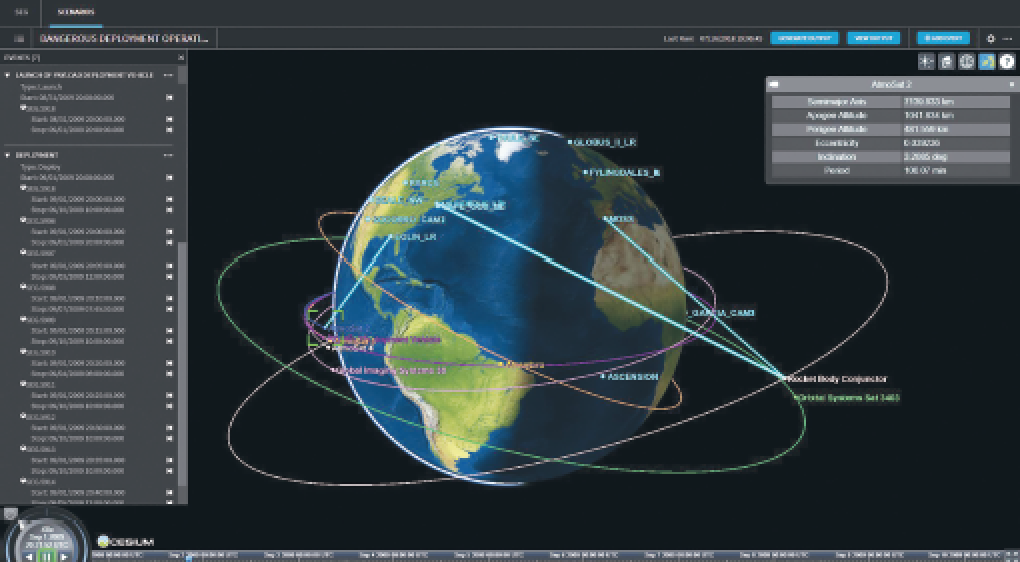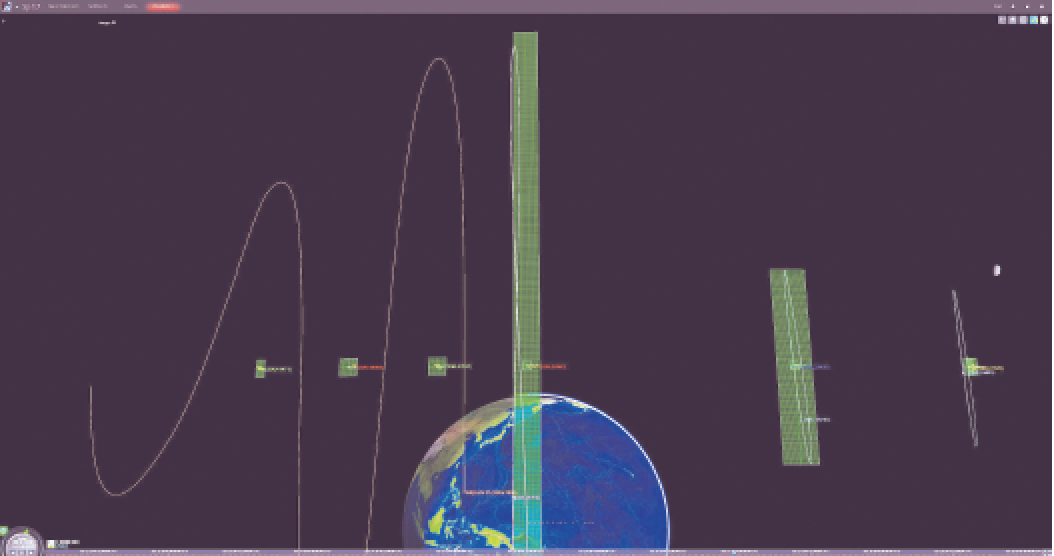Those of us who are well-connected within the space community hear the continuous drum beat of adversaries improving their organic space capabilities, closing the gap of the United States’ competitive advantage in the domain.
 Modeling complex events allows operators to train with realistic conditions. Image courtesy of AGI’s Space Event Generator.
Modeling complex events allows operators to train with realistic conditions. Image courtesy of AGI’s Space Event Generator.
Social media is replete with examples, blogs, posts, articles, and commentary regarding the rapid advance of space technologies and the lowering cost of access to space.
What’s to be Done?
For the last 30 years, the vast majority of space professionals have focused on problems unique to their specific task, specific platform, or specific mission with little regard to the interaction between platforms or missions within the domain, nor has there been enough advanced thought in a multi-domain (i.e., space, air, cyber, land, sea, etc.) environment. In this rapidly paced dynamic environment, developing warfighter expertise has never been more critical; current operations environments cannot support a culture of trial and error with the limited number of very expensive on-orbit assets.
A realistic, simulation capability for space missions is necessary today to meet this emerging threat.
As is similar in other domains, space weapons system expertise can and should be developed via sophisticated simulation capabilities: a phased approach from understanding basic Keplerian motion in Earth orbit to mission-specific tasks.
Simulation is essential for efficient job performance and to develop progressive tactics, techniques, and procedures in an environment that allows for failure and where operators can experiment without retribution.
Intuitive tools, especially in three dimensions, help current generation operators quickly grasp the interaction between objects and take away the guess work when using “flat” presentation software or hand-held models.
A derivative benefit from the 3D visualization is the ease of describing both real and projected space object interaction to decision makers.
It’s been an interesting… and accelerating… evolution of the complex space environment. Space threats are traditionally discussed as a concept in some comfortable future reality and in presentations of finite individual capabilities. However, the reality is that our single threat, single target mentality, leaves us unprepared for the realities we’re experiencing today.
How do we prepare for this emerging complex and dynamic system of systems environment?
 Shijian-17, a Chinese satellite launched in November of 2016, executes a close approach to a commercial satellite in early 2018. Image courtesy of AGI’s Commercial Space Operations Center.
Shijian-17, a Chinese satellite launched in November of 2016, executes a close approach to a commercial satellite in early 2018. Image courtesy of AGI’s Commercial Space Operations Center.
First and foremost is solidifying operational knowledge of our own systems. Reinvigorating expert knowledge of our satellite systems, subsystems, components, and features is the foundation we stand on when conceiving of threats to those systems.
Cursory knowledge and routinely following checklists does not prepare us to expect the unexpected or to be innovative in times of crisis.
The good news is our senior thought leaders across government, civil and commercial communities have reinvigorated this weapon system expertise approach, hearkening back 30+ years ago to the early days of satellite operations.
Next, detecting threats as early as possible preserves the widest possible array of response options. A human-in-the-loop may be necessary for the foreseeable future, but leveraging machine-to-machine automation and artificial intelligence to model system behaviors can help extract clues from seemingly otherwise disparate data sources.
Stitching together likely tips and cues to alert a control center of a pending risk to operations is critical. This can be achieved by exposing many and diverse data sources to a central node where the data can be processed and analyzed in near real time with tailorable mechanisms in place to alert different control center audiences of those indicators that are most relevant to their specialties.
Quickly communicating threat warning and response actions across operations centers and up to senior management levels ensures the correct-sized action is selected to counter the threat. Facilitating this rapid response is aided by working from a common set of tools that interact efficiently in a machine-to-machine fashion.
Common tools in a common framework, especially if that framework reaches through and between classification levels allows data exchange and collaboration in effective ways. Linking diverse networks at geographically separated locations is necessary so decisions are supported at the speed of need.
A sophisticated space training capability has never been needed more than in today’s complex threat environment. Most delivered space systems do come with detailed vendor software that are platform specific and highly technical. The problem is our organizational space culture emphasizes short learning timelines, rapid movement between functional specialties, and an up-or-out mentality. Compound this with our current culture phenomenon of continuous partial attention and we have a real and compelling challenge to overcome.
Current U.S. Air Force Space Command initiatives are attacking this lack of weapons’ system expertise in earnest. Individual unit training has transformed over the last five years with the Space Mission Force concept to cycle the most experience operators back into the operational crew force.
Multi-unit Advanced Training “sprints” emphasize and leverage critical thinking in the domain and enable synchronization of response efforts. Nascent or untested response options continue to be evaluated via a robust series of experiments, exercises and war-games. Most recently, the advent of advanced, multi-mission, multi-unit Space Flag capstone events are introducing collaboration and improving our response readiness in both predictable and unpredictable ways. We’re able to quickly validate or invalidate our domain assumptions and address new, unexpected challenges.
The key to these multiple layers of training is the ability to work with common, consistent, tailorable, and realistic simulation tools that accurately represent both the finer details of the systems they model and also build in the dynamics of space environment. An added benefit to using these common tools is that it helps to establish the “language” used when different units, in different locations, need to share their perspectives of the situation and animate their preferred courses of action in a way that can be coupled with other units’ actions.
These are exciting times within the space operations community. Rapid advancements in technology, vastly increased numbers of space-faring nations, and a national-level awareness of the importance of space to our way of life, means that our time to leverage information technology to our full advantage is here now.
It’s imperative for all us to bring the full force of our capabilities to bear, be transparent, accept critical peer review, and improve and advance the mission area for the generations of space professionals to follow in our footsteps.
www.agi.com/ss

Mike Wasson is AGI’s Senior Director for Department of Defense, Space Operations business development with over 30 years of space operations experience in satellite C2, launch range operations, space control and space surveillance within the U.S. Air Force, Civil Service, and commercial sectors.
Meet Mike at the 35th Space Symposium in Booth #515.

